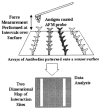Atomic force microscopy as a tool applied to nano/biosensors
- PMID: 22969400
- PMCID: PMC3436029
- DOI: 10.3390/s120608278
Atomic force microscopy as a tool applied to nano/biosensors
Abstract
This review article discusses and documents the basic concepts and principles of nano/biosensors. More specifically, we comment on the use of Chemical Force Microscopy (CFM) to study various aspects of architectural and chemical design details of specific molecules and polymers and its influence on the control of chemical interactions between the Atomic Force Microscopy (AFM) tip and the sample. This technique is based on the fabrication of nanomechanical cantilever sensors (NCS) and microcantilever-based biosensors (MC-B), which can provide, depending on the application, rapid, sensitive, simple and low-cost in situ detection. Besides, it can provide high repeatability and reproducibility. Here, we review the applications of CFM through some application examples which should function as methodological questions to understand and transform this tool into a reliable source of data. This section is followed by a description of the theoretical principle and usage of the functionalized NCS and MC-B technique in several fields, such as agriculture, biotechnology and immunoassay. Finally, we hope this review will help the reader to appreciate how important the tools CFM, NCS and MC-B are for characterization and understanding of systems on the atomic scale.
Keywords: atomic force microscopy; atomic force spectroscopy; nanoscience; nanosensors; nanotechnology.
Figures









Similar articles
-
High-resolution noncontact atomic force microscopy.Nanotechnology. 2009 Jul 1;20(26):260201. doi: 10.1088/0957-4484/20/26/260201. Epub 2009 Jun 10. Nanotechnology. 2009. PMID: 19531843
-
Atomic force microscopy as an imaging tool to study the bio/nonbio complexes.J Microsc. 2020 Dec;280(3):241-251. doi: 10.1111/jmi.12936. Epub 2020 Jun 17. J Microsc. 2020. PMID: 32519330
-
New modes for subsurface atomic force microscopy through nanomechanical coupling.Nat Nanotechnol. 2010 Feb;5(2):105-9. doi: 10.1038/nnano.2009.454. Epub 2009 Dec 20. Nat Nanotechnol. 2010. PMID: 20023642
-
Advanced nanotechnological approaches for designing protein-based "lab-on-chips" sensors on porous silicon wafer.Recent Pat DNA Gene Seq. 2007;1(1):1-7. doi: 10.2174/187221507779814470. Recent Pat DNA Gene Seq. 2007. PMID: 19075914 Review.
-
A review on: atomic force microscopy applied to nano-mechanics of the cell.Adv Biochem Eng Biotechnol. 2010;119:47-61. doi: 10.1007/10_2008_41. Adv Biochem Eng Biotechnol. 2010. PMID: 19343307 Review.
Cited by
-
Investigation on blind tip reconstruction errors caused by sample features.Sensors (Basel). 2014 Dec 5;14(12):23159-75. doi: 10.3390/s141223159. Sensors (Basel). 2014. PMID: 25490584 Free PMC article.
-
Recent Applications of Advanced Atomic Force Microscopy in Polymer Science: A Review.Polymers (Basel). 2020 May 17;12(5):1142. doi: 10.3390/polym12051142. Polymers (Basel). 2020. PMID: 32429499 Free PMC article. Review.
-
Nanoscale Phenotypic Textures of Yersinia pestis Across Environmentally-Relevant Matrices.Microorganisms. 2020 Jan 23;8(2):160. doi: 10.3390/microorganisms8020160. Microorganisms. 2020. PMID: 31979277 Free PMC article.
-
Understanding Calcium-Mediated Adhesion of Nanomaterials in Reservoir Fluids by Insights from Molecular Dynamics Simulations.Sci Rep. 2019 Jul 24;9(1):10763. doi: 10.1038/s41598-019-46999-8. Sci Rep. 2019. PMID: 31341192 Free PMC article.
-
Force-Induced Visualization of Nucleic Acid Functions with Single-Nucleotide Resolution.Sensors (Basel). 2023 Sep 8;23(18):7762. doi: 10.3390/s23187762. Sensors (Basel). 2023. PMID: 37765816 Free PMC article.
References
-
- Thundat T., Majumdar A., editors. Sensors and Sensing in Biology and Engineering. Springer-Verlag; Wien, New York, NY, USA: 2003. p. 399.
-
- Fagan B.C., Tipple C.A., Xue Z., Sepaniak M.J., Datskos P.G. Modification of micro-cantilever sensors with sol-gels to enhance performance and immobilize chemically selective phases. Talanta. 2000;53:599–608. - PubMed
-
- Carrascosa L.G., Moreno M., Alvarez M., Lechuga L.M. Nanomechanical biosensors: A new sensing tool. Trac Trend Anal. Chem. 2006;25:196–206.
-
- Swart J.W., Diniz J.A., Frateschi N.C., Fruett F., Moshkalev S. Nanotecologia e Semicondutores. In: Vaz C.M.P., Junior Herrmann P.S.P., Melo W.L.B., editors. Visão Tecnológica e Social para o Agronegócio. Ciclo de Colóquios da Embrapa Instrumentação Agropecuária; São Carlos, Brasil: 2008. pp. 41–64.
-
- Pei J., Feng T.F., Thundat T. Glucose biosensor based on the microcantilever. Anal. Chem. 2004;76:292–297. - PubMed
Publication types
MeSH terms
Substances
LinkOut - more resources
Full Text Sources
Miscellaneous

